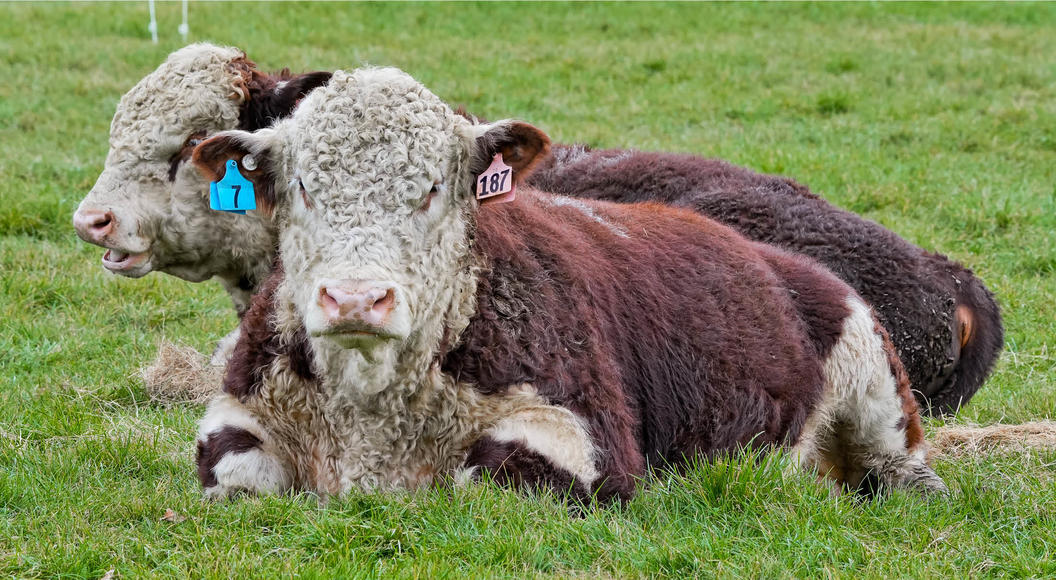
Unique white Herefords keep family legacy alive
Unusual variant attracting attention for more than 90 years.
While Hereford cattle are traditionally red bodied with white heads and other markings, a Wanganui cattle breeder has a theory, supported by more than 90 years’ of evidence, that there may be more to the breed.
Lindsay Johnstone, along with his wife Maria, owns Ranui Angus, a well-established stud now located at Kai Iwi, though originally set up by Lindsay’s grandfather Lindsay Campbell Johnstone in Te Puke in 1947.
While the association with Angus is long, dating even further back and again via his grandfather, Lindsay keeps a few Herefords, though with a particular and striking difference: the Ranui Herefords are pure white.
“My grandfather’s first white Hereford was born 92 years ago, and although that wasn’t intentional, it became a special interest he carried on for the rest of his life. I was seven years old when my grandfather gave me my first white Hereford calf, Candy, for pets day. I’ve kept them ever since, and we now have a small, genetically distinct herd,” he says.
Although some neighbours think they are Charolais, they are definitely Herefords, and they plenty of interest.
“As far as we know, they are unique in the country, if not the world. Crossing them with other breeds, you end up with a roan calf, either a red roan from a Hereford or Jersey or a blue from an Angus or Friesian, always essentially with the Hereford look. They are good looking cows, and an interesting option for beef or dairy farmers,” says Lindsay.
Ranui sells a limited number of white Hereford bulls every year, and also has semen straws available to anyone wanting to introduce the unique genetics to their herd.
PGG Wrightson Livestock National Genetics Manager Callum Stewart does regular business with Ranui Angus and is also keen on the white Herefords.
“While maintaining all the traditional Hereford traits associated with productivity and temperament, they are decorative cattle: something different to look at in the paddock, and an interesting talking point. The Johnstone family is to be congratulated for applying sound breeding practices over many decades to establish and maintain this unusual cow as a viable alternative to the classic Hereford,” says Callum.
As well as the white Hereford herd, Lindsay has documentation of his unique cows’ origin from an article about grandfather Johnstone, published in the New Zealand Journal of Agriculture, August 1967.
When farming in Whatwhata with Hereford cows mated with Hereford bulls, in September 1931 one of Lindsay Campbell Johnstone’s cows unexpectedly dropped a white calf with a light dusting of red roan along each side that, when subsequently bred from, repeated the white colouring.
Over time the Johnstone herd produced more white cattle, and by 1947 he had 35 light roan cows, though when Mr. Johnstone moved from Whatwhata to Te Puke, only one of the whites made the journey.
In Te Puke Mr. Johnstone decided to change his breed, bringing in Angus bulls to put over his Herefords. When his one remaining white Hereford calved to an Angus bull, the calf’s colour was again unusual: this time a blue roan instead of a red roan, again repeated in subsequent years, though otherwise with Hereford characteristics.
At that time white Shorthorn bulls crossed with Angus cows were favoured to produce blue roans, which attracted a premium, suggesting to Mr Johnstone that he could intensify the white of his roan cattle and eliminate the blue hairs. His theory was that they should produce blues across his Angus cows. By line breeding among the roans, with each generation he increased the percentage of white in the coats of the progeny, and at the fourth cross produced the first all-white calf, moving over later years to producing whites to order, genetically approximately 90 per cent Hereford.
Neighbours were sceptical, suggesting the herd was white Shorthorn, not Herefords, which Mr Johnstone disproved by lending out some of his white bulls, resulting in three dairy herds with calves out of Friesian, Jersey and Shorthorn cows, all showing true Hereford characteristics.
Historical cattle texts from Herefordshire list white animals in the 1860s, suggesting the source of the white coats was white cattle from Flanders, crossed on the native cattle in the 17th century.
The Journal article 55 years ago concluded: “It seems that Mr. Johnstone has rescued from oblivion a strain of cattle which was thought lost. They are good cattle but what is their future? I would hazard a guess that their future lies in the production of blue roans out of Aberdeen Angus cows and of colour-marked calves out of dairy cows.”
That future now belongs to the contemporary Lindsay Johnstone, who has kept the herd going ever since, with their distinctive white coats on otherwise recognisably Hereford characteristics.
To watch the full video, click here.


